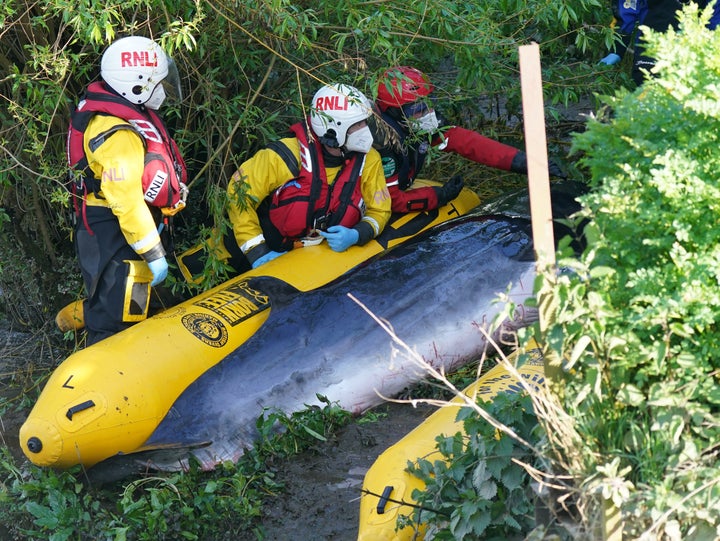A minke whale stranded along the River Thames is to be put down after a two-day struggle to save the animal.
Hundreds of people gathered at Richmond Lock and Weir on Sunday after the small animal, thought to be between 10ft (3m) and 13ft (4m) long, became stuck on the lock’s boat rollers.
Videos showed it being hosed down while a vet performed a check-up at the river’s edge, before the Royal National Lifeboat Institute (RNLI) arrived at the scene to the cheers of onlookers at about 9pm.
The whale was found to be in poor health and was put on pontoons to make it more comfortable on Sunday night as it was decided then that it should be put to sleep. But it managed to get free and back into the river.
On Monday, crowds gathered at Teddington Lock in south-west London on Monday to catch a glimpse of the animal as it became trapped once more.
But the whale is now due to be put to sleep as it would not survive on its own in the sea, Julia Cable, national co-ordinator at the British Divers Marine Life Rescue service, said.
“The vets are here from London Zoo. They will give the whale a large anaesthetic dose which will put it to sleep,” Cable said.
“The whale shouldn’t feel anything.”
She added: “It’s always sad, but we now know that putting it back out into the open sea would have been sending it to starve out there.”

Cable said the whale was either still “maternally dependent” or recently weaned, based on its size.
“It will be socially dependent, so to be on its own something has happened.
“It has been separated from either its mother or a group,” she added.
“It’s in a nutritionally poor state, it’s also got injuries from stranding.
“We know it was stranded for five or seven hours yesterday, so all the time that happens the organs can get damaged as well.”
Cable said whales tend to appear in the Thames every year, although live strandings were rare.
She said: “We started off with beluga, then there was a humpback and then there was another minke, then a fin whale turned up.
“But this is the first in recent years of a live stranding.
“It’s not common and hopefully we won’t see it again for a while.”

Dan Jarvis, welfare development and field support officer at the British Divers Marine Life Rescue service, said rescuers were working in conjunction with the Cetacean Strandings Investigation Programme (CSIP) which carries out post-mortem examinations.
He said they are likely to need help from the Port of London Authority to make arrangements for the removal of the whale.
Jarvis said it would be a long journey for the stranded whale to make it back to the open sea, around 30 miles, and logistically a big task.
He said the whale was put on pontoons to make it more comfortable on Sunday night as it was decided then that it should be put to sleep.
“It actually managed to get free of the pontoons unfortunately and back into the river,” he said.
Reflecting on the likely conclusion, Jarvis said: “This is likely the case with stranded cetaceans.
“It’s for a very good reason they’ve come ashore.
“Sometimes it is by accident, they do get stranded, but usually sadly it is the case that they’re already seriously ill or badly injured.
“And there’s not a great deal we can do in that situation.”
The whale was spotted near Teddington Lock just after 10.20am on Monday, heading downstream towards Chiswick and back towards Richmond Lock and Weir.
Pictures showed passers-by and photographers lining the river on Monday afternoon, with the whale clearly visible in the water.
Minke whales are the smallest of the great whales, growing to about 33ft (10m).
They can usually be found throughout the northern Atlantic and Pacific Oceans.
Their range extends from the ice edge in the Arctic during the summer to near the equator during winter.
